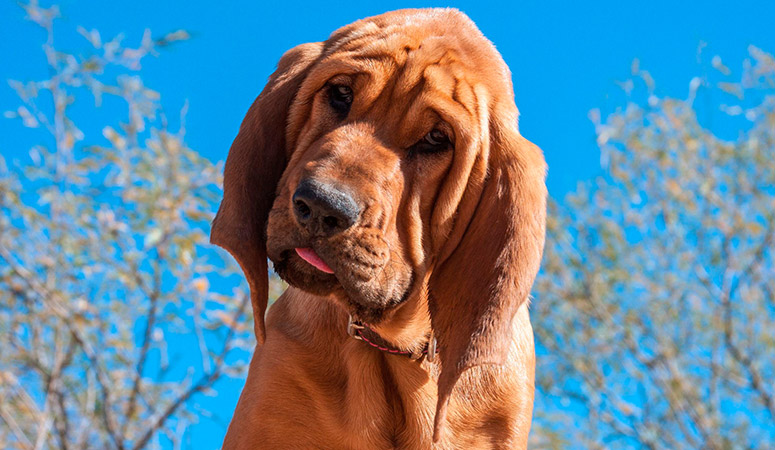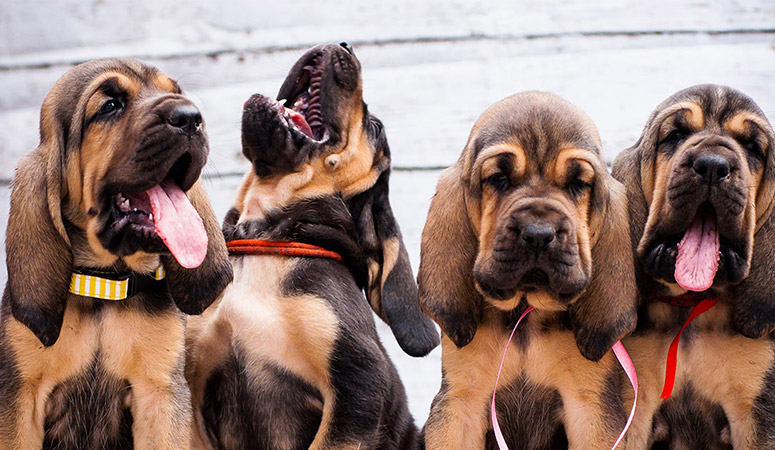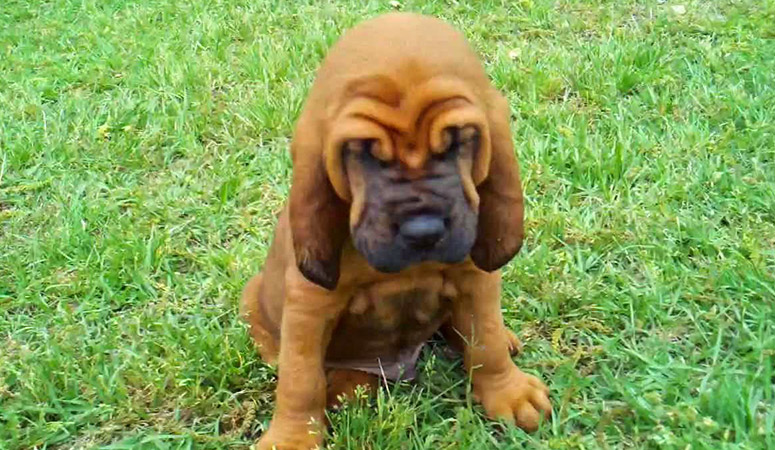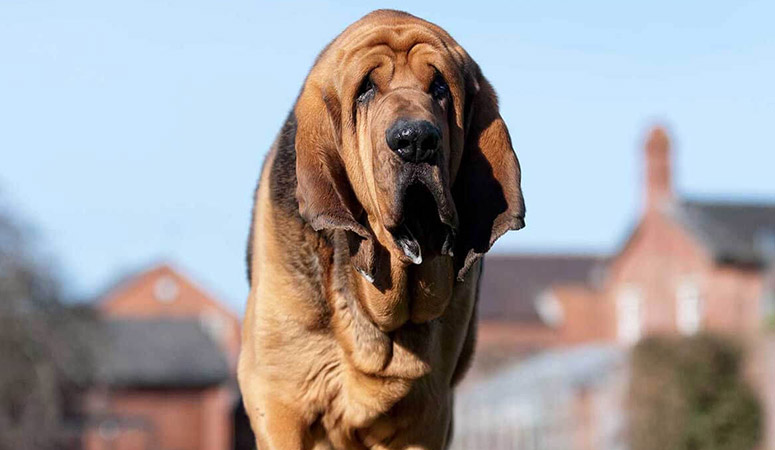Bloodhound
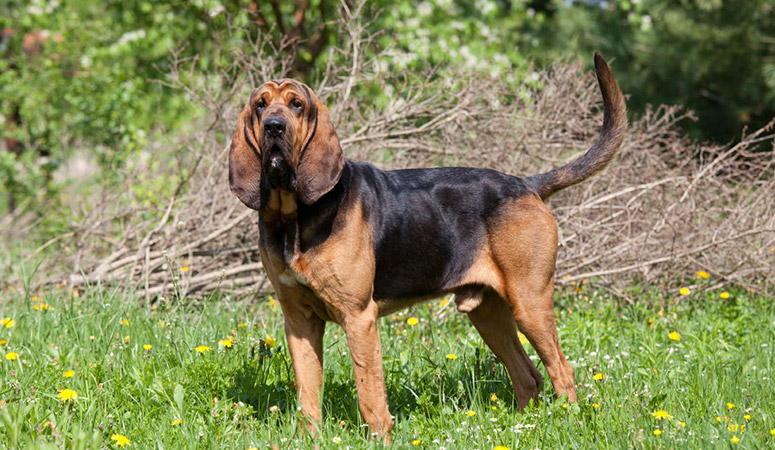
The Bloodhound was originated in medieval France to trail deer and boar. This breed has a keen sense of smell and can follow a scent even days later. Bloodhounds are tough, active, and intelligent, combined with their tracking instinct, they are often used by police and law enforcement to take part in the search and rescue activities, such as tracking lost people or escaped prisoners.
| Other Names | Chien De Saint Hubert, Chien de Saint-Hubert, St. Hubert Hound, St. Hubert’s Hound, St. Hubert’s Hound |
| Color | Black & Tan, Liver & Tan, Red |
| Height | Males: 25-27 inches. Females: 23-25 inches. |
| Weight | Males: 90-119 pounds. Females: 79-106 pounds. |
| Life Span | 10-12 years |
| Personality | Friendly, Independent, Inquisitive |
| Exercise | Regular Exercise |
| Origin |
| Popularity | #51 |
| Groom Needs | Weekly |
| Kids Friendly | Yes with supervision |
| Dog Friendly | Yes with supervision |
| Watch Dog | |
| Family Dog | Yes |
| Litter Size | 8-10 |
Bloodhound Pictures
Bloodhound Video
Introduction
A wrinkled face and dropping ears almost completely describe a modern-day Bloodhound. With a highly sensitive smell sense and powerful limbs, a Bloodhound was born ready to travel the miles following the trail of crime evidence or a wild game. Its short coat may come in a blend of black and tan, liver and tan, or red color.
As medium- to large-sized dogs, Bloodhounds pack the muscle mass to assist in their official duties. A standard male is likely to weigh around 95-115 pounds, standing at an impressive 26 or 27-inch height. A female Bloodhound is similarly built, albeit smaller — 23-25 inches height from paw to shoulder, and a weight of 80-105 pounds.
Bloodhounds can be stubborn occasionally, hence a strong leash would be a great idea on outings with this breed. They have an average life expectancy of 9-12 years.
Living with Bloodhound
The Bloodhound has a short, dense coat that is shed once or twice a year. Weekly brushing with a rubber hound mitt is enough to keep your Bloodhound neat, or you can do it more often if you prefer. Bloodhounds shed seasonally and you may need to use a shedding blade to remove excess hair during this period. Brushing also promotes new hair growth and distributes skin oils throughout the coat to keep it healthy.
The owners need to wipe the folds of the Bloodhound’s skin with a damp cloth every day in order to prevent bacterial infections. Do the same for the flews (the part of the upper lip that hangs) after every meal.
Bloodhounds should be bathed regularly to keep them from developing a doggy odor. And they are easy to get bad breath and rotting teeth, it is recommended to brush their teeth weekly, or daily is better.
Besides, Bloodhounds are prone to ear infections as their heavy, dropped ears which allow for virtually on air infections. Owners can use a cleaning solution every week to prevent harmful bacteria buildup. Trim your Bloodhound’s nails once a month, or as needed.
As an active dog breed, Bloodhound requires daily exercise which can be a few long walks and a play session or two in the yard. Moderate amounts of exercise keep them fit and healthy. Because it prefers to walk and sniff and explore, so it is recommended to take him on a leash when walking or short running or he may not respond to commands if he has found a scent to follow. When your dog playing in the backyard, it must be securely fenced because Bloodhounds are great diggers and escape artists. Bloodhounds don’t like hot weather, so it prefers to do outdoor exercise in the morning or evening.
Generally, it is to recommend feeding a Bloodhound with 4 to 8 cups of high-quality dry food divided into two meals per day. However, the food amount also needs to be based upon the Bloodhound’s activity level and age. A normal dog’s diet of meat and whole ingredients like vegetables and potatoes can really give your Bloodhound plenty to chew on.
Some dogs are easy to get overweight, so you need to watch their calorie consumption and weight level all the time. There should be clean fresh water at all times.
Treats may be an important aid in training, but excessive intake can lead to obesity. Also, owners need to distinguish which human food is safe for dogs and which are not. If you have any problems with your dog’s weight or diet, just consult from your veterinarian.
The Bloodhound may be prone to the following conditions: Eyelid issues, including ectropion and entropion, Skin-fold dermatitis, Ear infections, Hypothyroidism, Bloat/gastric torsion, Otitis externa, Canine hip and elbow dysplasia…
Major concerns: gastric torsion, skin-fold dermatitis, ectropion, entropion, CHD, elbow dysplasia, otitis externa
Minor concerns: hypothyroidism
Occasionally seen: degenerative myelopathy (DM)
Suggested tests:
Cardiac Exam
Hip Evaluation
Elbow Evaluation
Total Annual Cost: $3400
Cost is estimated for the first year and may vary depending on many factors, such as dog food, health care, leash, collar, licensing, possible fencing, crates, training and obedience classes, dog-walking, grooming, treats, toys, flea, tick, and heart-worm meds, microchips, etc.
For a Bloodhound, it’s best to start obedience classes early, as they are independent-minded and stubborn, it is better if the behaviors they hold onto for a lifetime are the behaviors the owner wants. If owners offer Bloodhounds plenty of praise and make training resemble playtime, they can learn the basics in short order.
Besides, Bloodhounds take well in advanced training. Mantrailing is a sport specifically aimed at scent hounds, which involves tracking the scent of people running and hiding in a trailing trial. If the dog is more skilled at the sport, he can even follow the scent after for a long period of time. Bloodhounds can also excel in agility training, conformation training, dog sports, and as a therapy dog.
History
The Bloodhound has a twisted French history, although it is believed to have been developed in England. Before the emergence of this breed of dogs, there was a hound breed that existed in the Saint-Hubert Monastery in Belgium. This hound was named Saint Hubert or Chien de Saint Hubert and is widely acclaimed the ancestors of the Bloodhound and various other dog breeds. France is the ancestral home of most hounds and is accepted as the original place of Saint Hubert.
In the Middle Ages, Saint Huberts were employed in hunting, especially in trailing and tracking animals such as the boar, deer, and the like. For centuries, the hounds were the popular tracking and hunting dogs in France, since the 7th century C.E. By the time the Napoleonic wars had receded, and wild hunting had begun to knock out, the Saint Hubert’s had lost the most part of their popularity, and had dropped in demand.
The pure-bred Saint Huberts must have been imported into England around the 14 century or thereabouts. There are bits of evidence that the British nobility and royalty right up to the Victorian era had kept a tradition of breeding Bloodhounds, especially for their masterful skills in hunting and tracking the scent of a person or an animal. This was later believed to have given rise to the name of the breed as they were reputed to have a keen sense of blood smell.
Around, early 19th century, Bloodhounds developed in England were in high demand as the modern Saint Huberts were found to have diverged too widely from the original characteristics of the dog due to excessive crossbreeding. The Bloodhounds were regarded to possess characteristics that were closest to the ancestors of the breed. The rise of this dog to fame has been slow and tortuous, now they can be found in the highest population, of any part of the world, in America.
Helpful Information
Breed Club: AMERICAN BLOODHOUND CLUB
Breed Club Link: https://www.americanbloodhoundclub.org/
Breed Club Rescue:
Breed Club Rescue Link: https://www.americanbloodhoundclub.org/breeder-referral/

